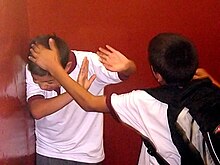| Conduct disorder | |
|---|---|
 | |
| Physical abuse and bullying, such as this boy attacking another boy, is a characteristic of a child with an established conduct disorder. | |
| Specialty | Psychiatry, pediatrics, clinical psychology |
| Symptoms | Maliciousness, bullying, abuse, crime, delinquency, truancy, substance abuse, injury, impulsivity |
| Complications | Sadomasochism, self-injury, crime, substance abuse, imprisonment, violence, antisocial personality disorder |
| Risk factors | Attention deficit hyperactivity disorder, schizophrenia, substance abuse, fetal alcohol syndrome, child physical abuse, maternal smoking during pregnancy, domestic violence, sexual bullying, molestation |
| Diagnostic method | Through a prolonged pattern of antisocial behaviour such as serious violation of laws, social norms, and rules in people younger than the age of 18 |
Conduct disorder (CD) is a mental disorder diagnosed in childhood or adolescence that presents itself through a repetitive and persistent pattern of behavior that includes theft, lies, physical violence that may lead to destruction, and reckless breaking of rules,[1] in which the basic rights of others or major age-appropriate norms are violated. These behaviors are often referred to as "antisocial behaviors",[2] and is often seen as the precursor to antisocial personality disorder; however, the latter, by definition, cannot be diagnosed until the individual is 18 years old.[3] Conduct disorder may result from parental rejection and neglect and can be treated with family therapy, as well as behavioral modifications and pharmacotherapy.[4] Conduct disorder is estimated to affect 51.1 million people globally as of 2013.[update][5]
- ^ Barzman, D (2017). "Conduct disorder and Its Clinical Management". The Lecturio Medical Concept Library. DeckerMed Medicine. Retrieved June 24, 2021.
- ^ Hinshaw, S. P.; Lee, S. S. (2003). Conduct and oppositional defiant disorders: Child psychopathology (E. J. Mash & R. A. Barkley ed.). New York: Guilford Press. pp. 144–198.
- ^ American Psychiatric Association (2013). Diagnostic and Statistical Manual of Mental Disorders (5th ed.). Arlington, VA: American Psychiatric Publishing. pp. 659. ISBN 978-0-89042-555-8.
- ^ Mohan, L; Yilanli, M; Ray, S (2020). "Conduct disorder". National Center for Biotechnology Information, U.S. National Library of Medicine. StatPearls Publishing LLC. PMID 29261891. Retrieved June 24, 2021.
- ^ Global Burden of Disease Study 2013 Collaborators (5 June 2015). "Global, Regional, and National Incidence, Prevalence, and Years Lived with Disability for 301 Acute and Chronic Diseases and Injuries in 188 Countries, 1990-2013: a Systematic Analysis for the Global Burden of Disease Study 2013". Lancet. 386 (9995): 743–800. doi:10.1016/S0140-6736(15)60692-4. PMC 4561509. PMID 26063472.